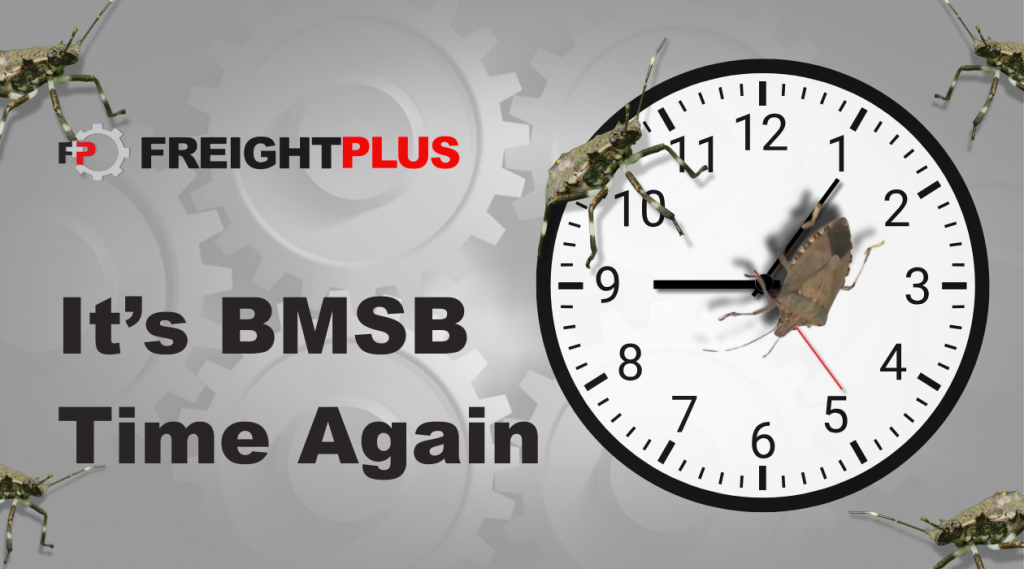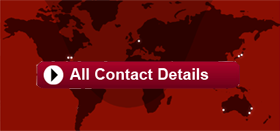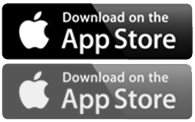International Freight for Heavy Industry
It’s BMSB Time Again
Seasonal measures for Brown marmorated stink bug (BMSB)
The 2025-26 Brown marmorated stink bug season kicks off next week on September 1 and will run inclusively until April 30 2026. As the beginning of the season approaches, Australia’s Department of Agriculture, Fisheries and Forestry (DAFF) has released its seasonal measures.
What’s new this season?
- Republic of Korea and Japan have been added to the emerging risk countries list
- Target high-risk goods arriving from the USA and China will be subject to random inspections
- Addition of a NEW offshore BMSB treatment option – Ethyl Fo4mate
- New application process for the BMSB in-transit and rolled policy.
BMSB measures for goods
- If your goods are classed as target high risk, they will require mandatory treatment.
- If your goods are classed as target risk, they will be subject to random inspection.
- If your goods are not found in either category, they are not subject to BMSB measures; however, they will be subject to the measures if packed with target high-risk or risk goods.
Goods shipped in ISO tanks and as bulk-in-holds of cargo vessels are not subject to the measures.
Treatment of target high-risk goods
- Target high-risk goods treated in target risk countries must be treated by a treatment provider listed as ‘approved’ on the List of treatment providers.
- Treatment certificates from target risk countries will not be accepted from unregistered treatment providers or treatment providers listed as ‘suspended’, ‘withdrawn’ or ‘under review’ on the List of Treatment Providers.
- Containerised goods will be directed for onshore treatment.
- Break bulk will be directed for export.
Breakbulk goods
- Break bulk includes those goods shipped on flat racks and in open-top containers.
- All target high-risk goods shipped as breakbulk must be treated offshore before arrival into Australia.
- Untreated break bulk will be denied discharge or directed for export.
- Onshore treatment is not permitted.
- Shipper Owned Containers (SOCs) and FCL containers that have been modified, such as those used to house in-built power generators, filtration plants, portable accommodation, etc., are no longer sealed in six hard-sided containers and are considered breakbulk cargo.
- Automated Entry Processing for Commodity (AEPCOMM) arrangements for BMSB is permitted for breakbulk goods. See relevant BICON commodities for assessment and outcomes.
Note: If you are importing target high risk goods as break bulk (including flat rack and open top containers) and it has not been treated offshore prior to arrival, you must answer ‘YES’ to community protection question 642 (BIOSECURITY: ARE THE GOODS ARRIVING IN AN OPEN TOP/FLAT RACK CONTAINER OR AS BREAK BULK, AND DO NOT MEET OFFSHORE BMSB TREATMENT REQUIREMENTS?). This includes Automated Entry Processing for Commodity (AEPCOMM) lodgements.
Containerised goods (FCL, FCX)
- Containerised cargo arriving in sealed six hard-sided containers with target high-risk goods can be treated offshore or onshore at the container level.
- Refrigerated containers (operating and non-operating) and hard top sealed containers (ISO22U6/ISO22UP, ISO42U6/ISO42UP and ISO45U6/ISO45UP) are deemed to be the same as six hard-sided sealed containers.
- Onshore treatment of goods is to occur at the container level. Deconsolidation or removal of goods from the container will not be permitted prior to treatment.
- Containers should be packed in a manner that will enable effective onshore treatment at the container level to avoid possible export of the container.
- AEPCOMM arrangements for BMSB is permitted for containerised goods shipped as FCL (Full Container Load) and FCX (Full Container Consolidated). See relevant BICON commodities for assessment and outcomes.
- A sealing declaration can be utilised for FCL / FCX containers in the following circumstances:
- Goods were containerised and sealed prior to 1 September, but shipped on board after this date; or
- The bill of lading does not state the shipped-on-board date; or
- Target high-risk goods were manufactured, packed and sealed in a container in a non-target risk country but have been shipped from a target risk country; or
- Goods were sealed inside the container within 120 hours of treatment occurring offshore (for treatments conducted prior to 1 December).
Note: Sealing declarations must be completed and signed by either the exporter, freight forwarder, or shipping company at the port of origin.
Note: Container tracking information is not an acceptable form of evidence to verify when goods were loaded on board the vessel or when goods were sealed in a container.
Containerised goods shipped as Less than Container Load (LCL) consignments and Freight of all Kinds (FAK) containers
LCL and FAK containers with target high risk goods will be managed at the container level for BMSB risk prior to deconsolidation. Once BMSB risk has been managed, the consignments within these containers will be processed at the Full Import Declaration (FID) level for all other biosecurity intervention (if applicable).
See the Management of LCL/FAK containers web page for more details.
Airfreight
Random inspections will apply to target high-risk goods shipped as airfreight from the United States of America and China between 1 September to 30 April (inclusive). BMSB treatment of these goods will not be required.
RO-RO
All ro-ro vessels that berth at, load, or tranship in target risk countries between 1 September and 30 April (inclusive) will be required to:
- Conduct at least one crew inspection and respond to specific questions as part of the pre-arrival reporting requirements; and
- Undergo a mandatory seasonal pest inspection on arrival in Australia.
For further information on BMSB seasonal measures for vessels, visit the Management of vessels web page.
Known risk pathways and supply chains
- Goods from known risk pathways and supply chains that have had previous detections of BMSB may be subject to BMSB intervention, including treatment and/or inspections.
Treatment of BMSB goods in Australia and New Zealand
- The BMSB seasonal measures are for goods being imported into Australian territory, and managing the risk associated for all goods that come into Australian territory.
- Australia will not be conducting BMSB treatments for goods transhipping to NZ.
- Goods bound for Australia cannot be treated for BMSB in New Zealand and vice versa. For example, if the goods have been exported from New Zealand for not meeting BMSB import conditions, they will not be permitted to be treated in Australia.
Target Risk Countries
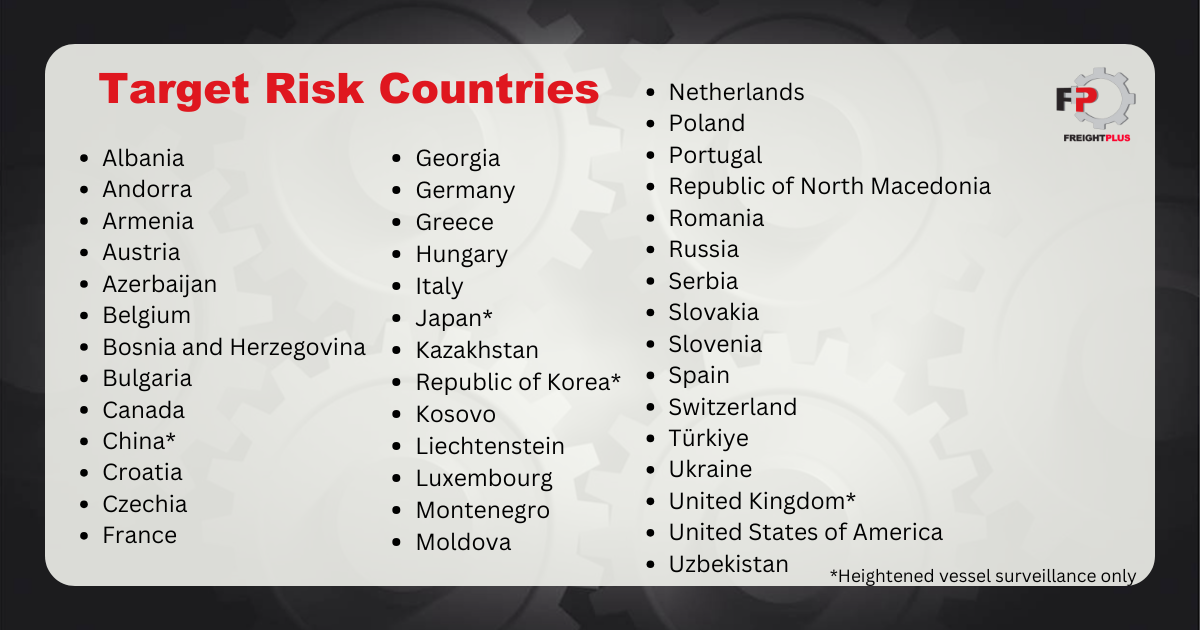
The following countries have been identified as emerging risk countries for the BMSB risk season and may be selected for a random onshore inspection: United Kingdom, China, Japan and the Republic of Korea.
- Random inspections will apply to goods shipped from the United Kingdom, China, Japan and the Republic of Korea between 1 September to 30 April (inclusive).
- In addition to the target high-risk goods, chapters 39, 94 and 95 will be subject to random inspections for emerging risk countries only.
What is heightened video surveillance?
Heightened vessel surveillance applies to all roll-on roll-off (Ro-Ro) vessels that have berthed, loaded or transhipped from target risk countries (with the addition of China, Japan and the Republic of Korea) between 1 September and 30 June. These vessels will be subject to a mandatory seasonal pest (SP) inspection on arrival in Australian territory. This is only applicable to the Ro-Ro vessels themselves and does not apply to goods on the vessel.
Target Risk Goods
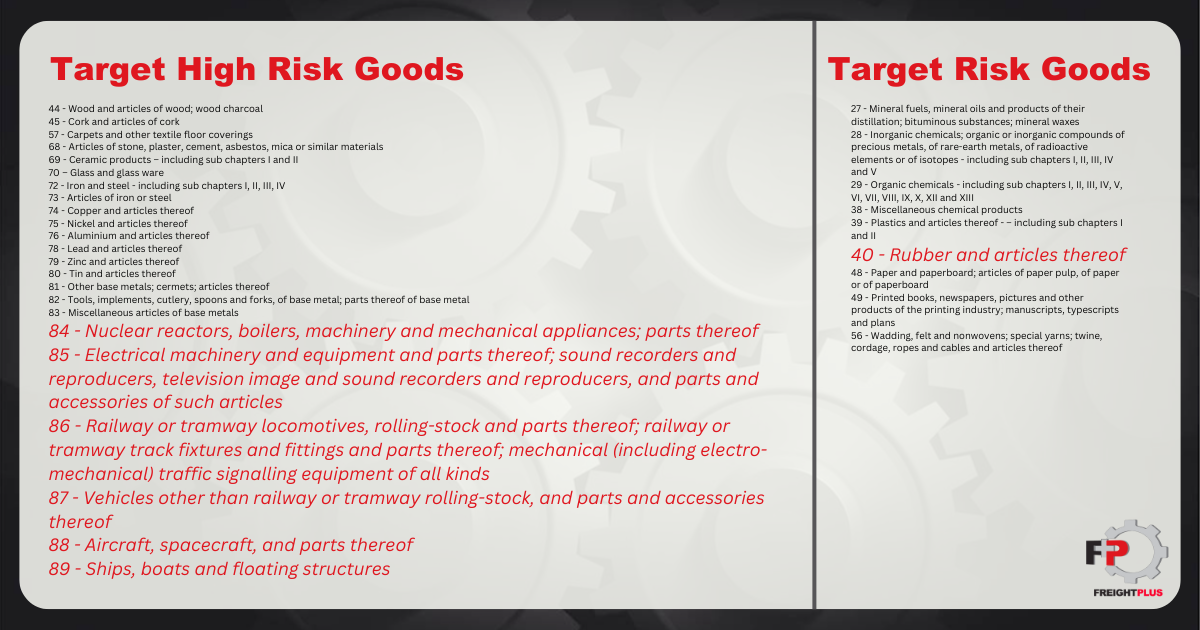
Target high-risk goods are goods that fall within the following tariff classifications and have been categorised as target high-risk goods and will require mandatory treatment for BMSB risk.
Target risk goods are goods that fall within the following tariff classifications and have been categorised as target risk goods and are only subject to increased onshore intervention through random inspection. Mandatory treatment is not required.
For all other goods that are not categorised as target high-risk and target risk goods, BMSB seasonal measures do not apply. However, if they are part of a container or consignment that contains target high-risk or target risk goods, they will be subject to the measures.
Measures for vessels
All ro-ro vessels that berth at, load, or tranship in target risk countries between 1 September and 30 April (inclusive) will be required to:
- Conduct at least one crew inspection and respond to specific questions as part of the pre-arrival reporting requirements; and
- Undergo a mandatory seasonal pest inspection on arrival in Australia.
For further information on BMSB seasonal measures for vessels, visit the Management of vessels web page.
Treatment types
There are four approved treatment options for BMSB treatment: heat, methyl bromide, sulfuryl fluoride, ethyl formate.
Heat
For all good types and sizes
- 56°C or higher at the coldest surface of the goods, for a minimum of 30 minutes
or - for individual goods weighing less than 3000 kg shipped as break bulk only, 60°C or higher at the coldest surface of the goods, for a minimum of 10 minutes
Note: Individual goods shipped as break bulk weighing less than 3000kg treated at 60°C for 10 minutes require evidence within shipping documentation that they are less than 3000kg for these treatments to be accepted.
Methyl Bromide
- A dose of 24 g/m³ or above, at 10°C or above, for a minimum of 12 hours (but less than 24 hours), and a minimum end point reading of 12 g/m³
or - A dose of 24 g/m³ or above, at 10°C or above, for 24 hours or longer, and a minimum end point reading of 8 g/m³
Note:
- All start time concentration readings must be above 24 g/m³.
- Dose increases to compensate for temperatures less than 10°C is NOT permitted.
- Topping up with additional fumigant at the end of treatment is NOT permitted.
- If the concentration of fumigant falls below the minimum end point reading at any point during the treatment, the treatment has failed.
Sulfuryl Fluoride
- A dose of 24 g/m³ or above, at 10°C or above, for a minimum of 12 hours (but less than 24 hours), and a minimum end point reading of 12 g/m³
or - A dose of 24 g/m³ or above, at 10°C or above, for 24 hours or longer, and a minimum end point reading of 8 g/m³
Note:
- All start time concentration readings must be above 24 g/m³.
- Dose increases to compensate for temperatures less than 10°C is NOT permitted.
- Topping up with additional fumigant at the end of treatment is NOT permitted.
- If the concentration of fumigant falls below the minimum end point reading at any point during the treatment, the treatment has failed.
Sulfuryl Fluoride – Using third-party system*
- Achieve a CT of 200 g-h/m³ or more, at 10°c or above, for 12 hours or longer, with a minimum end point reading of 12 g/m³
or - Achieve a CT of 200 g-h/m³ or more, at 10°C or above, for 24 hours or longer, with a minimum end point reading of 8 g/m³
Note:
The approved stewardship program operators and their third party programs are:
- Douglas Products or their agents – FumiGuide
- Ensystex II, Inc. (USA) – Fumicalc
- Barcan Barcan Pest Control & Fumigation Co. (Barcan ilaclama Fumigasyon Tic. Ltd.Sti.) (Turkey) – FumiTrack
Topping up with additional fumigant at the end of treatment is NOT permitted. If the concentration of fumigant falls below the minimum end point reading at any point during the treatment, the treatment has failed.
Ethyl Formate
Approved for offshore treatments only.
All ethyl formate treatments must be performed at 10°C and above and have a minimum end point reading for ethyl formate of 15 g/m³.
For a formulation of 16.7% ethyl formate with 83.3% carbon dioxide
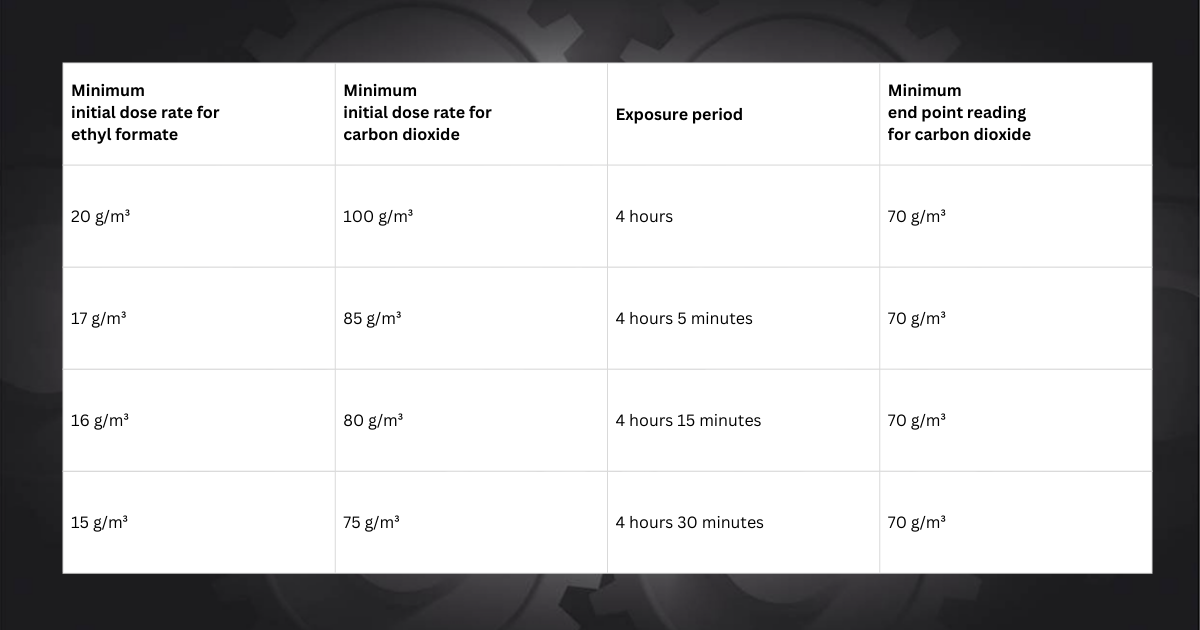
Note:
- Dose increases to compensate for temperatures less than 10°C is NOT permitted.
- Topping up with additional fumigant at the end of treatment is NOT permitted.
- If the concentration of fumigant falls below the minimum end point reading at any point during the treatment, the treatment has failed.
Treatment minimum standards
There are set minimum standards for the application of BMSB treatments. Treatments applied for biosecurity purposes are part of managing the risk of introducing exotic pests and diseases.
It is important that treatment providers understand these requirements as treatments to manage risk are only effective when conducted correctly. These standards outline best practice methodologies for applying biosecurity treatments.
Onshore treatment
Where onshore treatment of goods is permitted, you can find a list of approved arrangement providers on the department’s website.
Offshore treatment
AusTreat sets out the department’s registration and compliance requirements for offshore treatment providers, including compliance with applicable treatment methodologies.
Further information can be found on the AusTreat webpage.
Treatment providers in target risk countries
All offshore treatment providers performing BMSB treatments in target risk countries must be registered under AusTreat and listed as ‘approved’ on the List of treatment providers prior to treatment. Treatments conducted by an unapproved treatment provider in a target risk country will be deemed as invalid and the goods will be subject to onshore treatment (if permitted) or directed
for export.
Treatment providers in non-target risk countries
Treatment providers in other countries who intend to conduct BMSB treatments for goods that are manufactured in or shipped from any of the target risk countries are encouraged to register under an offshore treatment assurance scheme.
Treatment certificates issued by a treatment provider in non-target risk country will be accepted unless the:
- treatment provider is listed as ‘suspended’, ‘withdrawn’ or ‘under review’ on the List of treatment providers,
or - unregistered treatment provider is listed as ‘unacceptable’ or ‘under review’ on our webpage.
Fraudulent certificates
The department continues to improve its systems to monitor and detect the use of fraudulent certificates and will identify consignments that arrive in Australia with fraudulent documentation.
Any consignment identified with a fraudulent certificate will be directed for onshore treatment (if permitted) or exported.
Freightplus can help minimise the BMSB biosecurity risks on your cargo
For more information on our biosecurity services or the upcoming BMSB season please contact your local Freightplus office.

